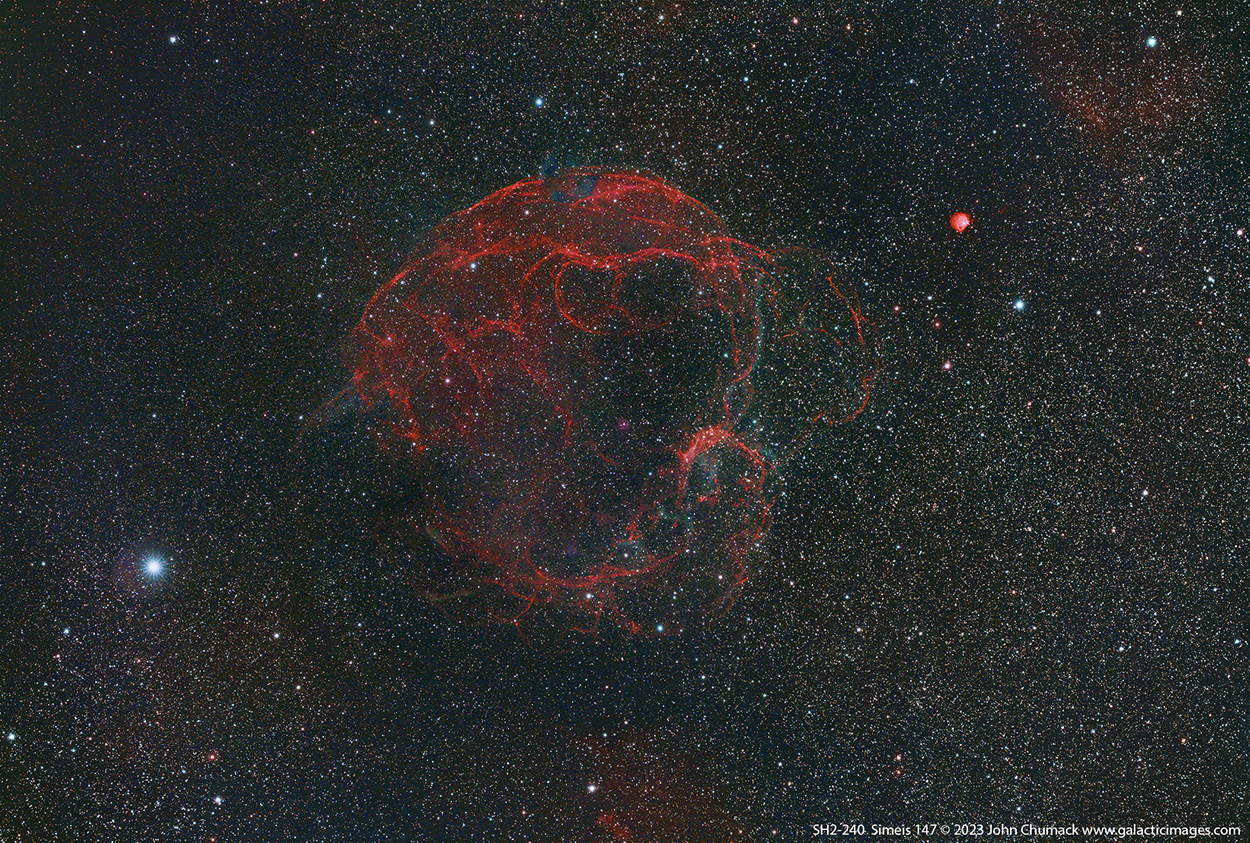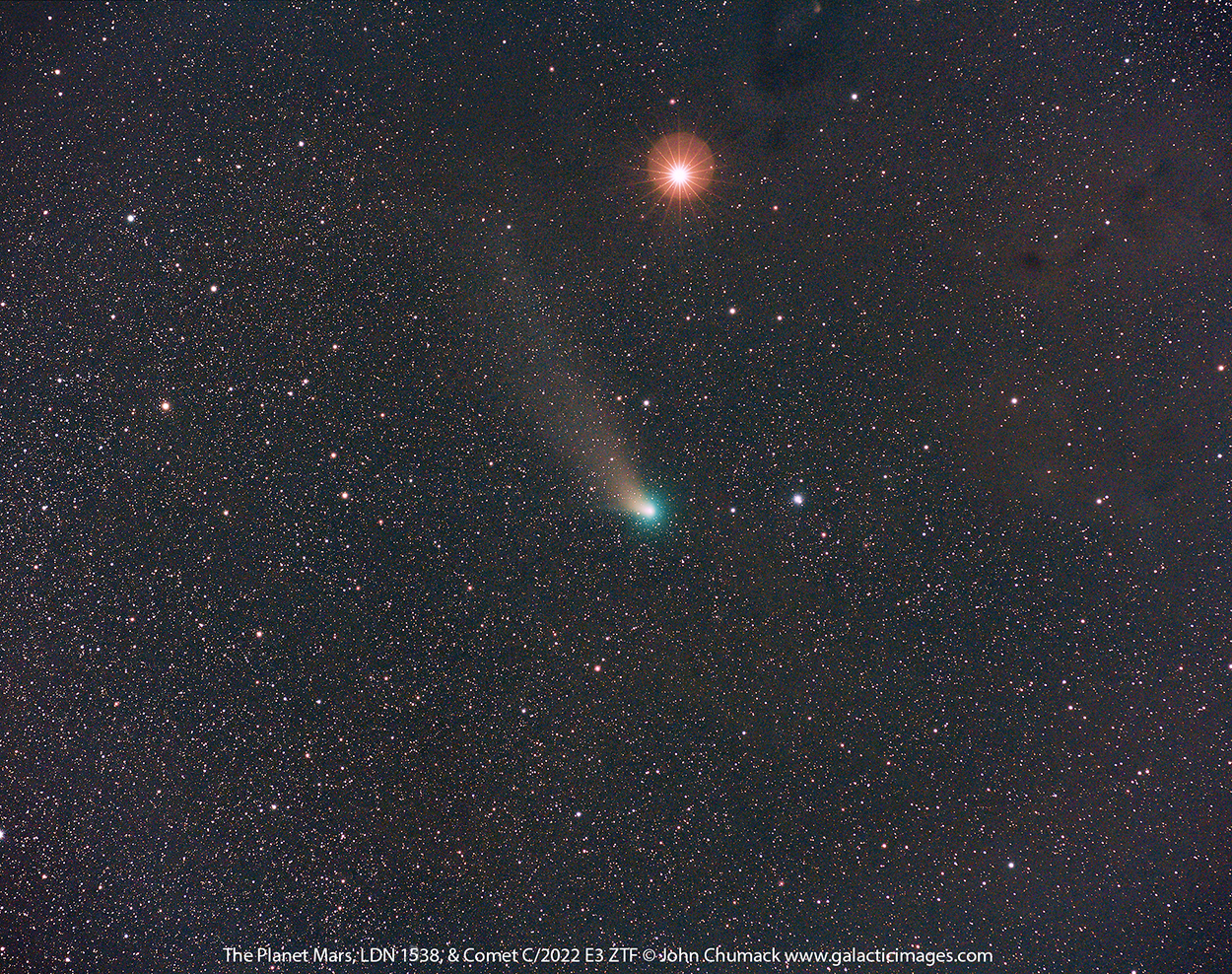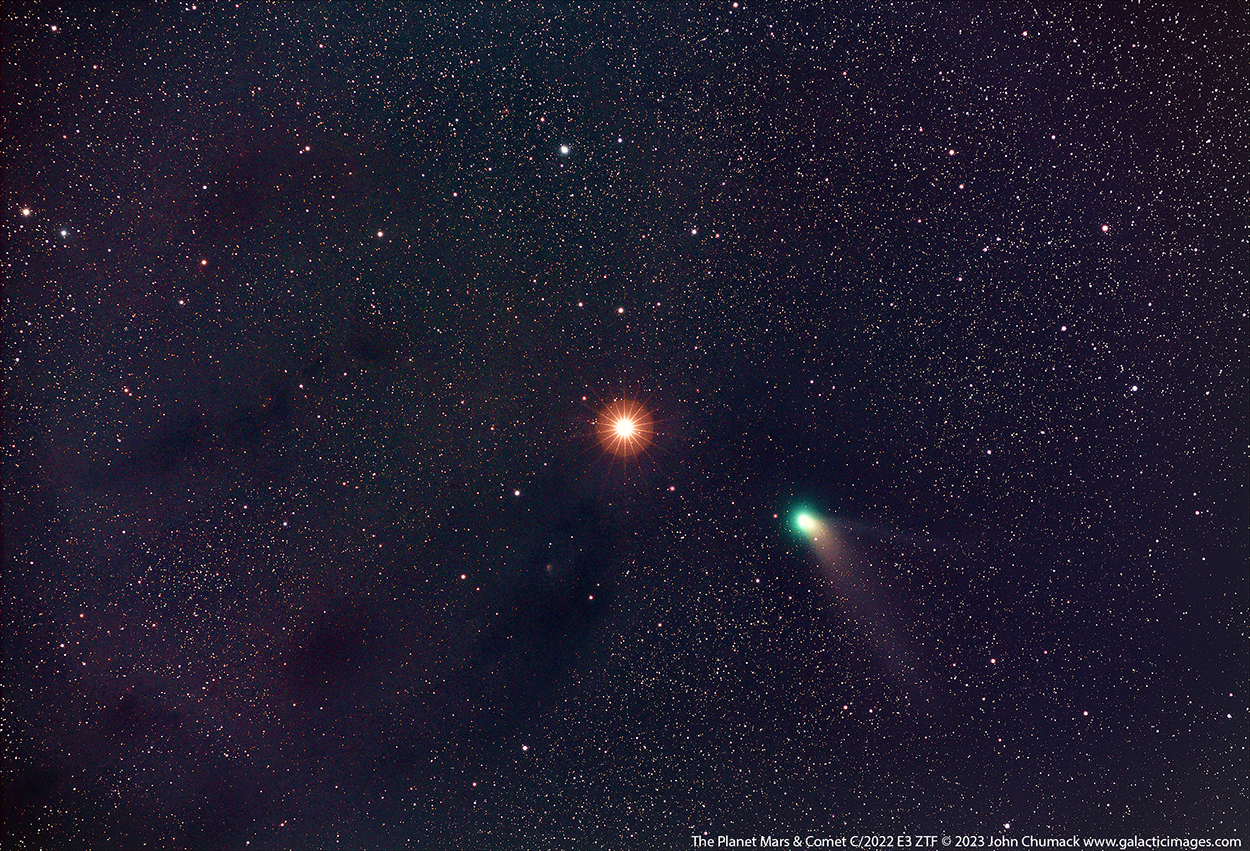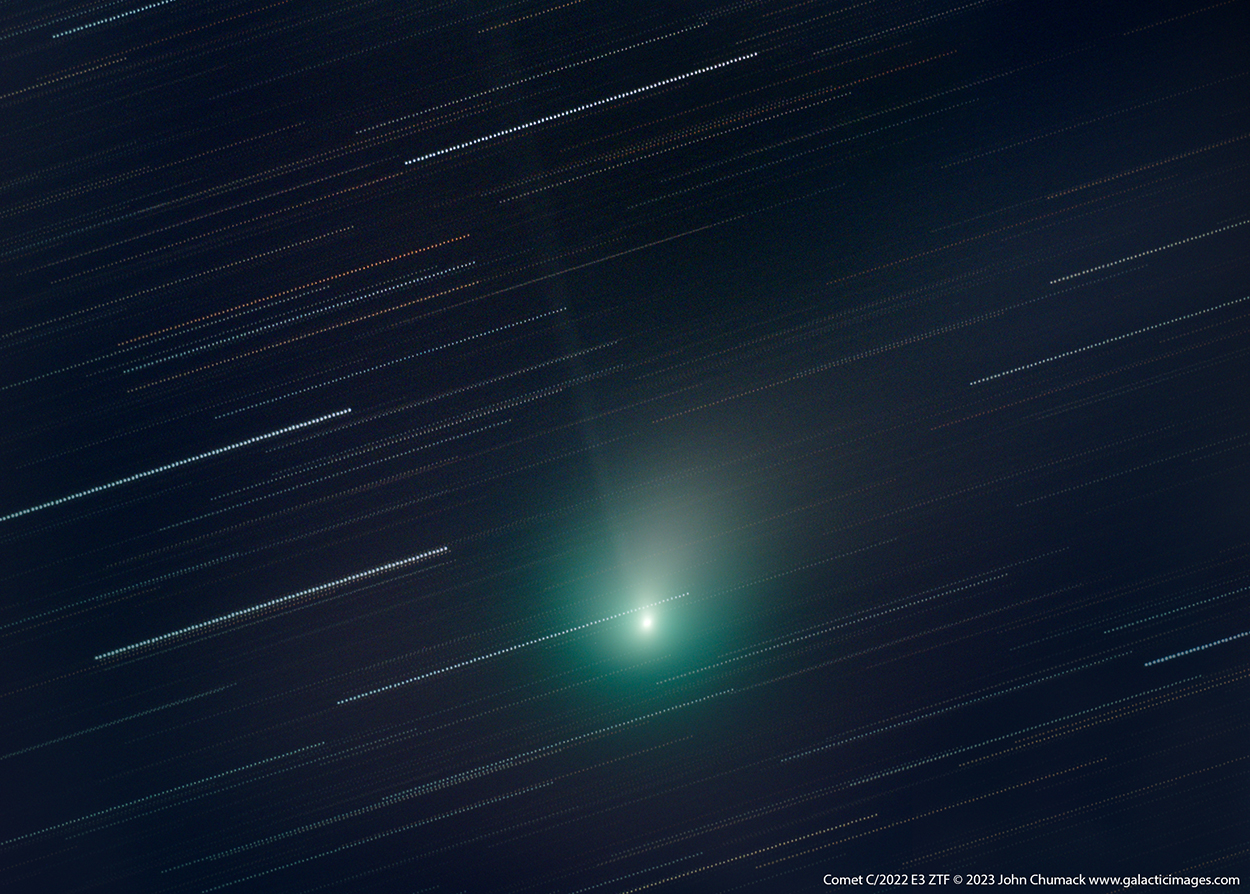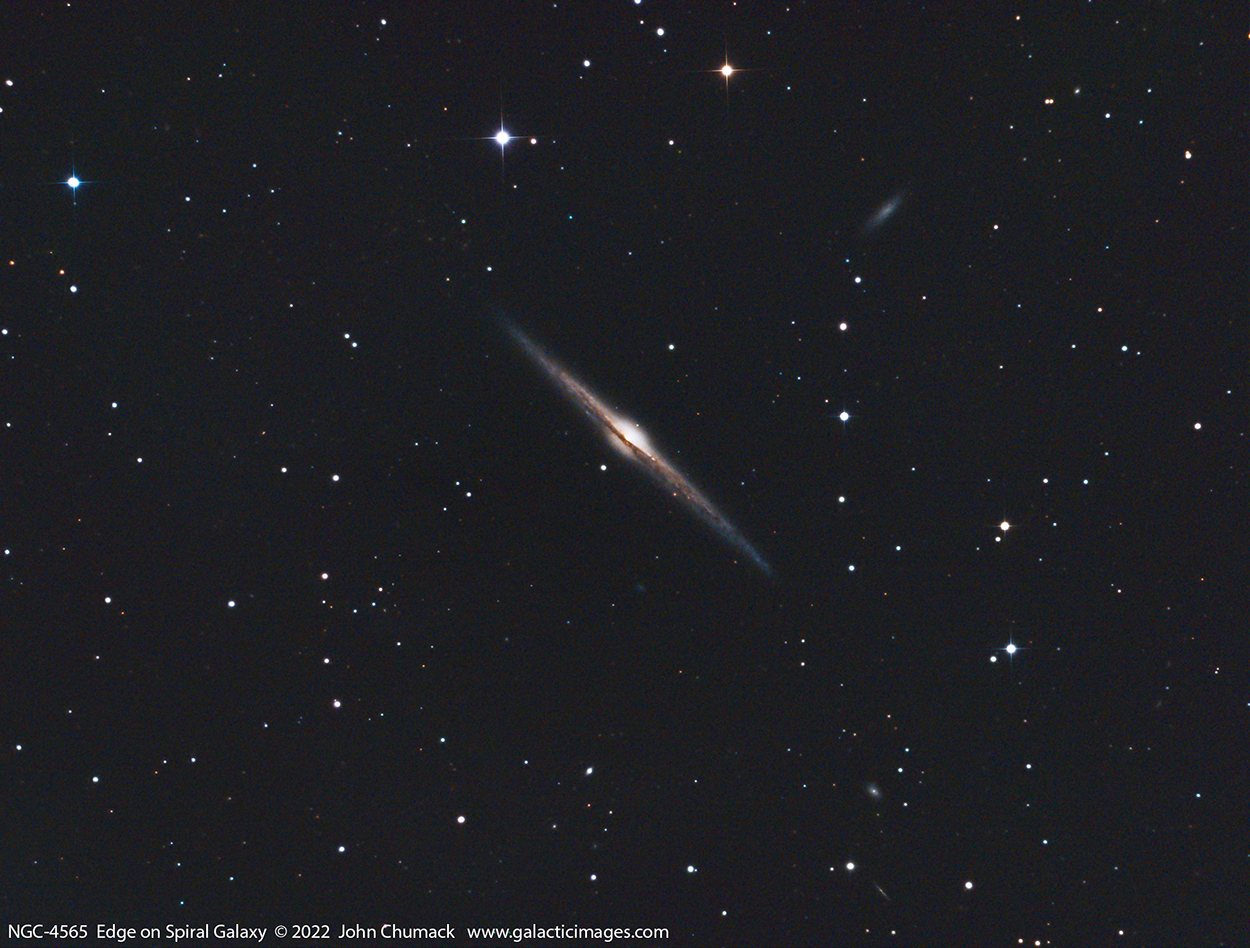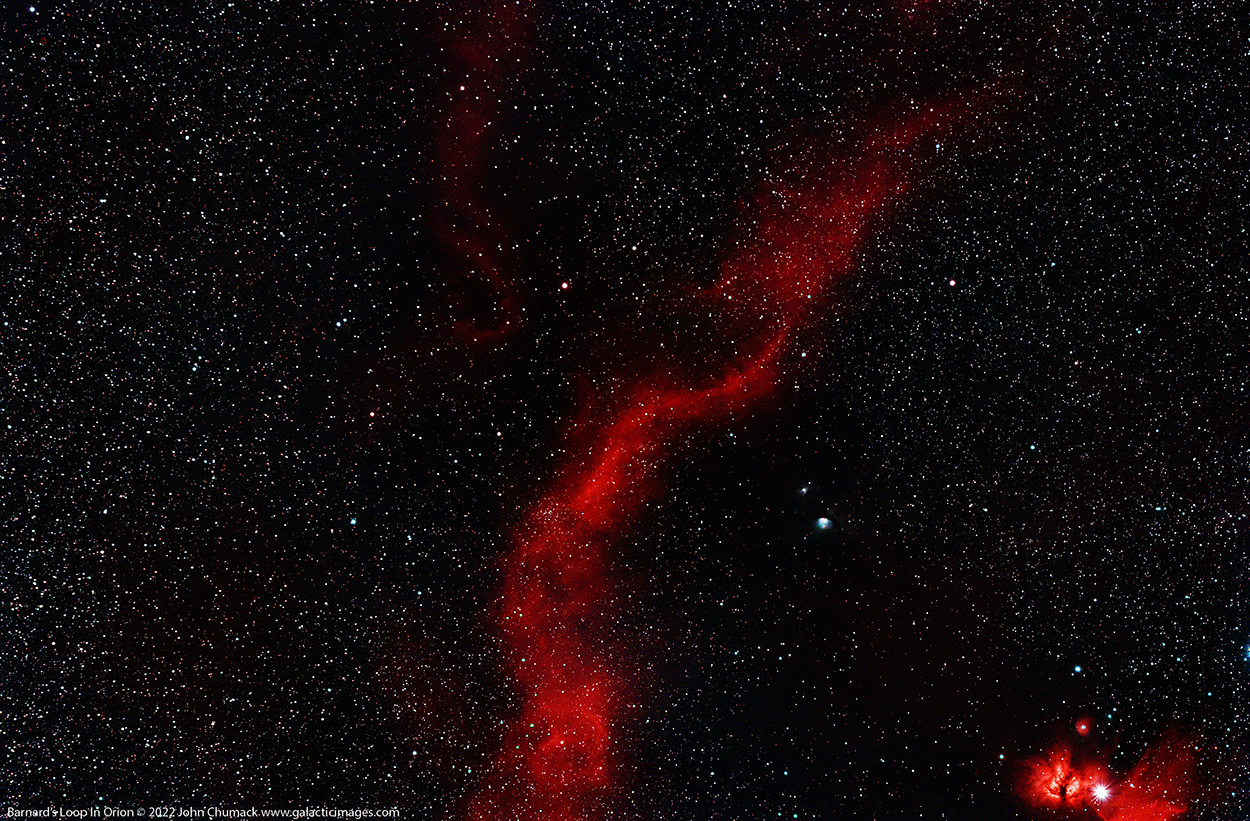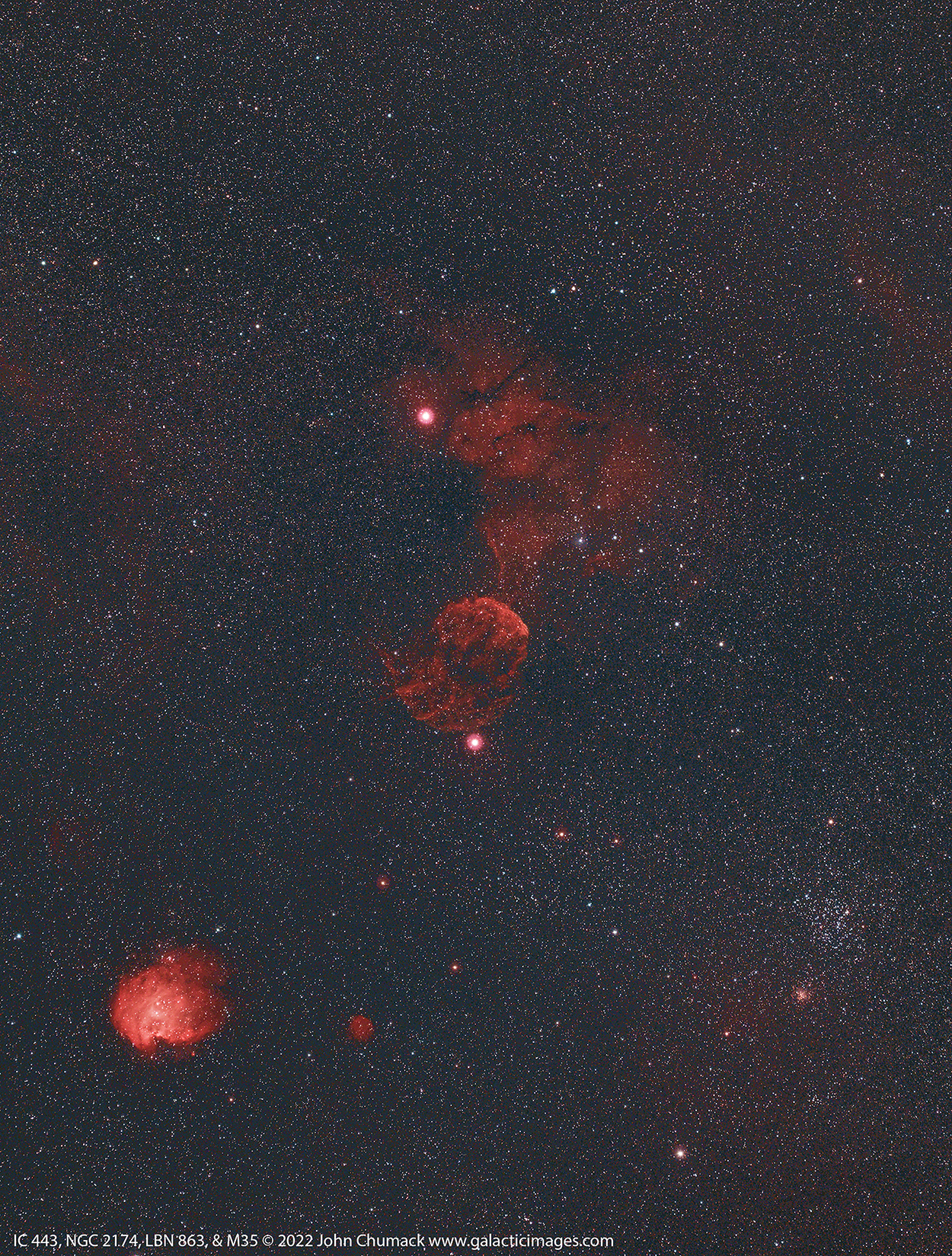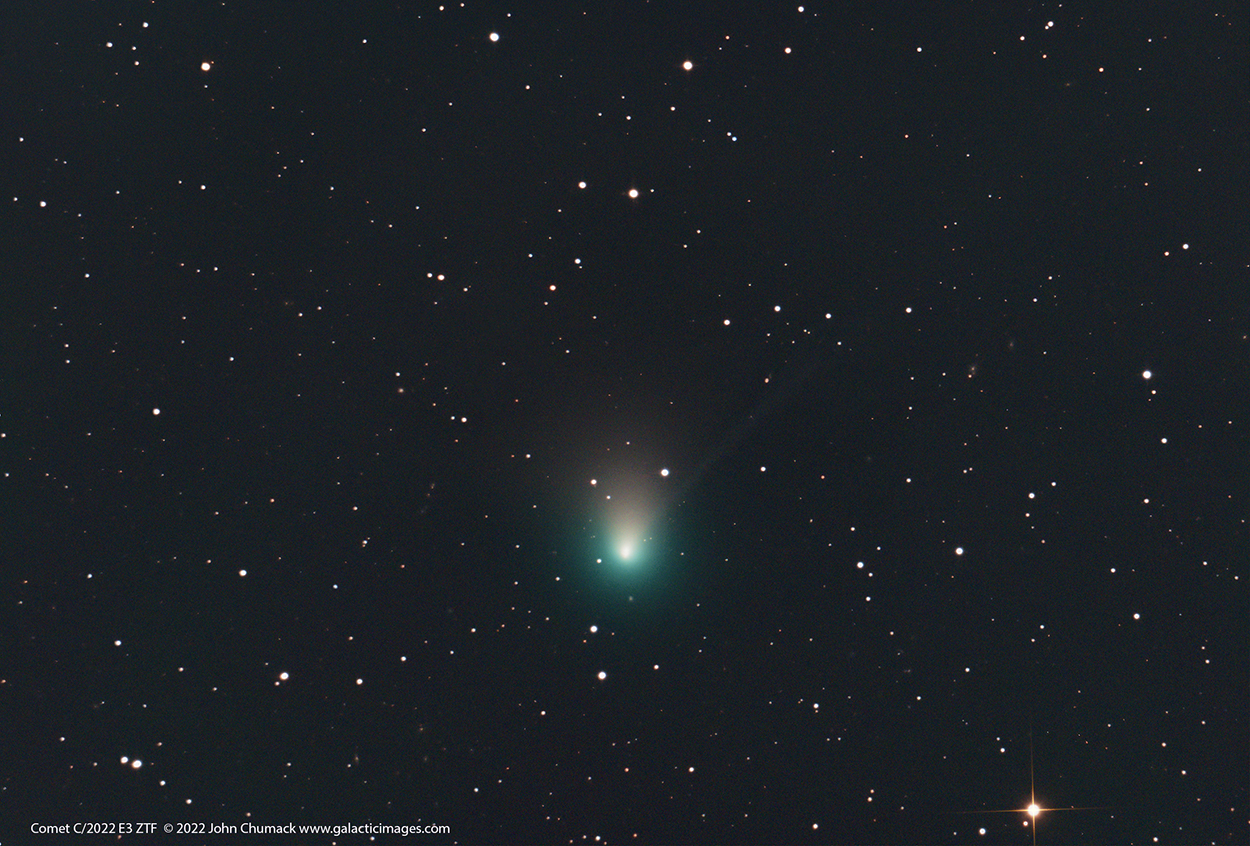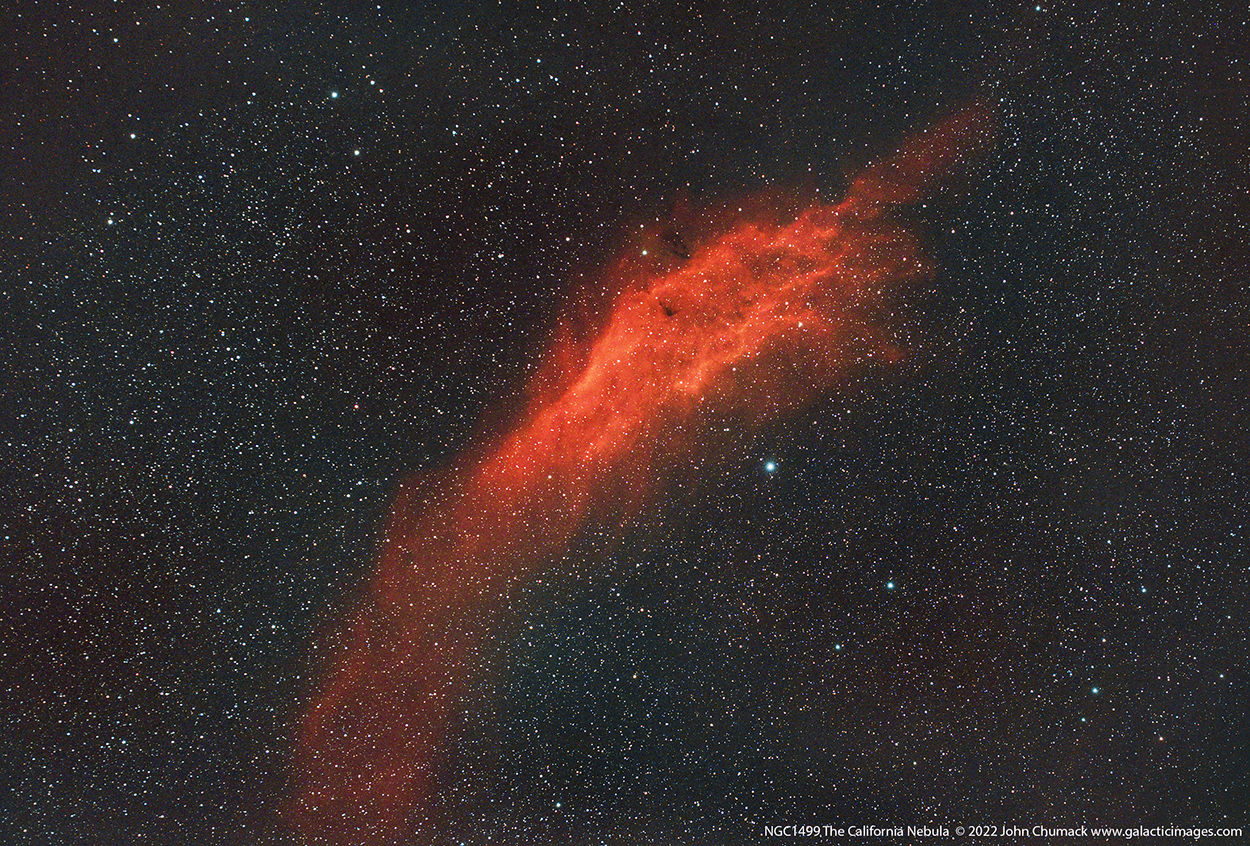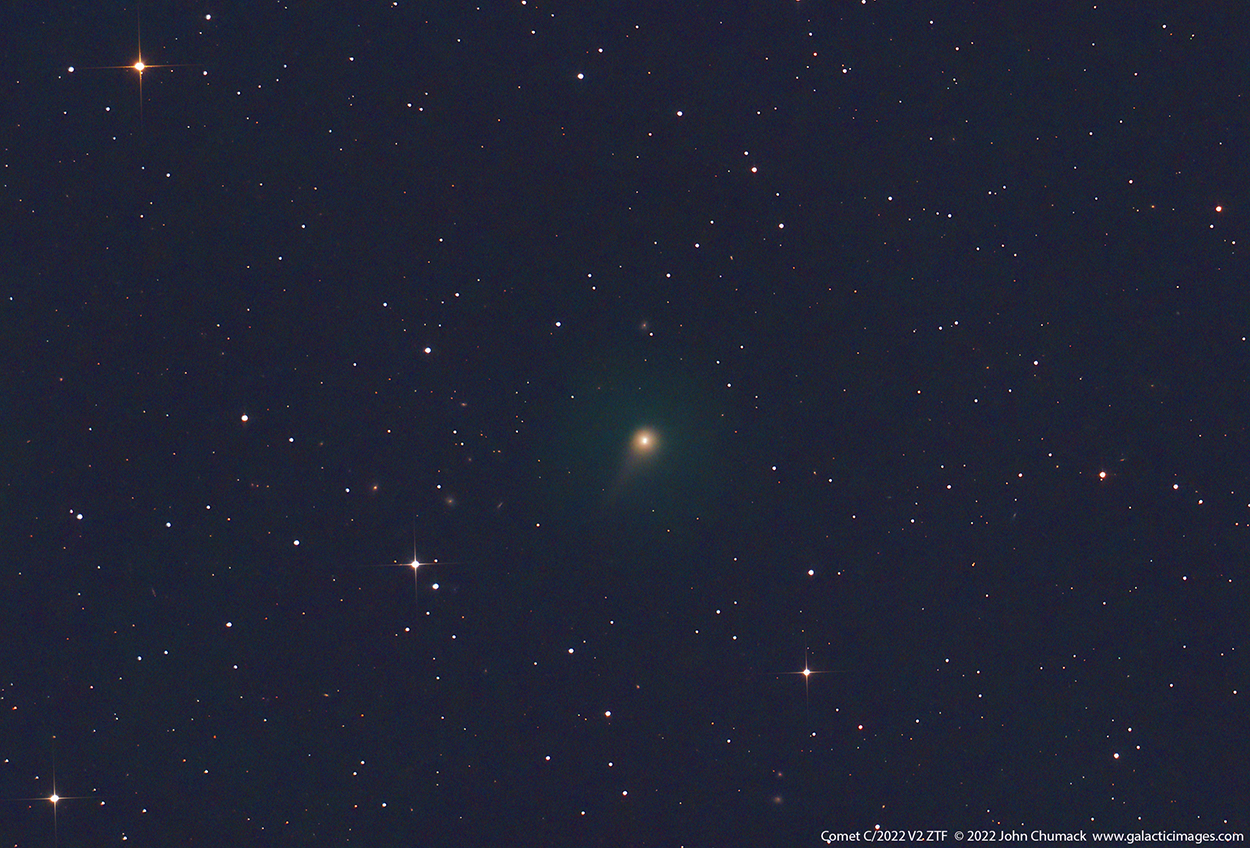Sh2-240 (Simeis 147) The Spaghetti Nebula (SNR) in Taurus
Comet C/2022 E3 ZTF is now moving away from Mars 02/12/2023 UT
The Planet Mars & Comet C/2022 E3 ZTF
The Planet Mars & Comet c/2022 E3 ZTF on 02/11/2023 Centered on 04:05 UT. (22:54 to 23:18 LT 02/10/2023) A nice wide angle shot!
You can see the Comet approaching Mars and some of the Dark Dusty Nebulae Clouds of Taurus are also visible in the background.
This looked Awesome in my 10×70 Fujinon Binoculars, the color contrast was beautiful, and the comet’s glowing coma was so easy to see. Greg and I watched it for a while last night at JBSPO.
I captured this with a Samyang 135mm Lens @ F4, L-Pro Filter, ZWO AM5 Mount, ASI Air Plus, via Wi-Fi to my I-Pad, ZWO 294mc Cooled Cmos Camera, (12 x 2 minute subs) 24 minutes total integration time, from my observatories at JBSPO in Yellow Springs, Ohio.
Best Regards,
John Chumack
www.galacticimages.com
Comet C/2022 E3 ZTF on 02/04/2023
NGC-4565 Edge on Spiral Galaxy – (short exposure)
Every year I have to take a shot of one of my favorite Galaxies, it is a Beautiful Edge on Spiral Galaxy, both visually and photographically.
NGC 4565 Edge on Spiral Galaxy in Coma Berenices, (also known as the Needle Galaxy or Caldwell 38)
is an edge-on spiral galaxy about 42 million light-years away in the constellation Coma Berenices.
It lies close to the North Galactic Pole and has a visual magnitude of approximately 10.4.
It is known as the Needle Galaxy for its narrow profile, the core of the galaxy contains 240 Globular star clusters,
more than the Milky Way. NGC 4565 is one of the brightest members of the Coma Galaxy Group.
I only captured 24 minutes of data on this one due to clouds rolling in and ending my imaging run, but it still looks decent enough to share.
Look carefully near the bottom of this image in the background is another needle like edge on Galaxy.
TPO 12″ F4 Newtonian telescope, Bisque ME Mount,
ZWO 294MC cooled Cmos Camera, L-Pro filter, Baader Coma Corrector,
ASI Air Plus, via Wi-Fi to I-Pad, 12 x 2 minute subs, 24 minute exposure total Integration time.
Calibrated & Stacked in ASTAP, Processed in Pixinsight, Adobe Raw CC 2023.
Captured from my Observatories at JBSPO in Yellow Springs, Ohio.
Best Regards,
John Chumack
Barnard’s Loop in Orion Sh2-276
A wide Field Shot of the IC 443 Jelly Fish Nebula Region
Here is my nice deep wide field shot of the Jelly Fish Nebula in Gemini
along with some of its neighbors. No telescope, just a Samyang 135mm lens this time.
At center are the two bright stars Mu & Eta Geminorum (Tejat Posterior & Propus)
with IC 443 The Jelly Fish Nebula(A Supernova Remnant) also known as Sharpless 248 (Sh2-248)
located 4,892 light years away in the constellation Gemini.
NGC 2174 The Monkey Head Nebula (bottom left)
LBN 863 Nebula (bottom middle)
M35 Open Star Cluster (bottom right)
NGC 2158 one of the oldest Open Star Clusters in our galaxy(just below M35)
NGC 2157 Open Star Cluster(just below NGC 2158)
Captured with a Samyang 135mm F2 lens, ZWO 294MC cooled Cmos Camera, Bisque MyT Mount, L-enhance filter,
ASI Air Plus via Wi-Fi to Ipad, 60 x 2 minute subs, 120 minute total integration exposure time on 12/19/2022 from my backyard(bortle8) in Dayton, Ohio.
Best Regards,
John Chumack
www.galacticimages.com
Comet C/2022 E3 ZTF on 12-29-2022 at 09:53 UT
Happy New Year Everyone, and hopefully this Beautiful comet will brighten your New Year. You can see the bright Nucleus, the nice Green Coma, the (brown) dust tail, and also the faint Ion tail going off to the right. I only got 24 minutes of data before the clouds kill it for me that early morning. you can see some faint PGC galaxies in the background and in the lower right bright 7th magnitude star (HIP 77721).
Comet C/2022 E3 ZTF on 12-29-2022 09:53 UT
Shining at ~8.2 magnitude in the constellation Corona Borealis
Captured with a TPO 12 inch F4 Newtonian Scope, ZWO 294MC Cooled Cmos Camera, L-Pro filter, Bisque ME Mount, ASI Air via Wi-Fi to I-pad, 12 x 2 minute subs, 24 minute total exposure. DSS, Nebulosity, Pixinsight, Adobe Raw CC 2023. Captured from my observatories at JBSPO in Yellow Springs, Ohio.
Best Regards,
John Chumack
www.galacticimages.com
The California Nebula (NGC 1499/Sh2-220)
The California Nebula (NGC 1499/Sh2-220) is an emission nebula located in the constellation Perseus.
Its name comes from its resemblance to the outline of the US State of California in long exposure photographs.
The brighter section is almost 2.5° long on the sky and, because of its very low surface brightness, it is extremely difficult to observe visually.
But Photographically it shows up very well in long exposures. In this image I also captured the fainter section near the bottom of the frame showing
it actually covers more than 5 degrees of sky. It lies at a distance of about 1,000 light years from Earth.
The California Nebula fluorescence is due to excitation of the Hβ(486nm) line in the nebula by the nearby energetic(Blue star in the lower right of the nebula) O7 star,
Xi Persei (also known as Menkib). It looks fantastic in the H-alpha(656nm) wavelength as well.
Capture with a Samyang 135mm F2 lens, Bisque MyT mount, ZWO 294mc Cooled Cmos Camera, L-enhance filter,
ASI Air Plus via Wi-Fi to my I-pad, 30 x 2 minute subs, 60 minute total exposure integration time.
From my backyard observatory(bortle8) in Dayton Ohio.
Best Regards,
John Chumack
www.galacticimages.com


